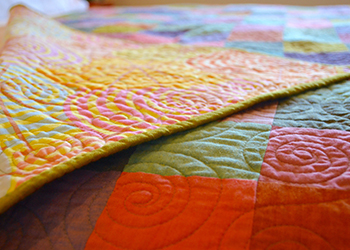
After working hard on a quilt top, it’s important to select a backing just as special as the top. Below are a few things to consider before selecting your quilt back.
Pattern or Print
Do you want the quilting to stand out or blend into the backing?
Solid or tone-on-tone fabrics with little or no designs make quilting stand out. The more colorful and patterned a fabric is the more quilting blends in.
If hand quilting or custom machine quilting, it is common to use a solid or tone-on-tone backing to highlight the quilting.
A colorful print will keep the attention on the fabric and off the quilting with an all-over quilting design.
When first learning to machine quilt, a busier fabric can camouflage the stitching.
If hiring a machine quilter, check with your quilter for their preference.
Color
When considering the color of the backing fabric, keep the value of the quilt top in mind. A darker backing can make the quilt front look a bit shadowed. A high contrast design on the backing fabric may peek through a lighter quilt top. To prevent this, use a backing the same value as the front of the quilt.
For a throw quilt, the back is often as visible a the front. Consider selecting a backing fabric that coordinates with the front or creates a great backdrop for the quilt front.
For a seasonal quilt front, selecting a large scale non-seasonal backing lets you use the quilt year round by flipping it over.
Before selecting a backing fabric, consider the quilting thread color. For example, if the quilt is quilted with white thread, a black backing would make it stand out. While a different thread can be loaded in the bobbin for the back of the quilt, if the top thread is pulled to the back in some places, a strongly contrasting backing fabric will highlight the issue.
Whole or Pieced Back
A pieced back is made by sewing lengths of fabric together to create the fabric backing. Sometimes it’s the same fabric, or it could be scraps left over after piecing the quilt top. It could also be a coordinating or statement fabrics sewn together to create a large scale design for the quilt back.
When piecing backs, it’s important to keep seams in mind. If the quilt front has lots of seams, adding more seams with a pieced back could make quilting challenging.
If piecing lengths of the same fabric together to create one backing, consider using a wide backing. It is often more economical and eliminates extra seams.